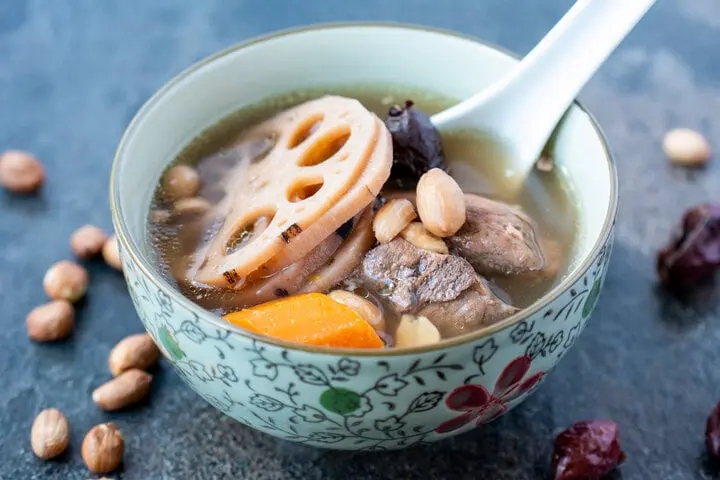Lotus root is a highly nutritious ingredient, offering a plethora of health benefits. With its refreshing taste, lotus root can be turned into various delicious dishes, such as lotus root salad, lotus root dessert soup, or lotus root stew.

The question of whether the 7-hole or 9-hole lotus root is tastier is on many people’s minds. (Photo: Maangchi)
Lotus root is an excellent source of iron, which helps with blood replenishment. It is also rich in vitamin C and antioxidants, as well as polysaccharides and polyphenols, which have cancer-fighting properties.
In traditional Chinese medicine, fresh lotus root is considered sweet in taste and cold in nature, making it effective in cooling the blood. It is also used to treat tuberculosis, nosebleeds, and insomnia. The water from fresh lotus root has a calming effect on those who are anxious or nervous. On the other hand, ripe lotus root benefits the spleen and stomach and is suitable for the elderly and nourishing for children.
Which is tastier, 7-hole or 9-hole lotus root?
When purchasing lotus root, consumers will notice two types: 7-hole and 9-hole. This naturally leads to the question of which one tastes better. In reality, these two varieties differ in flavor and are suited for different dishes.
The 7-hole lotus root, also known as red lotus root, has a brown-yellow skin with a thick and short appearance. Once cut open, you’ll find seven holes, and it has a bitter taste when eaten raw.

The 7-hole lotus root has a high starch content, low water content, and is not crispy, making it ideal for soups and stews. (Photo: Asian Inspirations)
The 7-hole lotus root usually has larger, shorter, and more rounded segments, and its skin is slightly rough. When cut in half, the flesh will appear yellowish or reddish.
This variety mainly grows in ponds and has a high starch content with a low water content, resulting in a soft and sticky texture when eaten. When cutting this lotus root, you may notice that the fibers between the segments can be stretched.
“What are some tasty dishes that can be made with lotus root?” Here are three easy and delicious recipes:
Overall, the 7-hole lotus root lacks crispness, so it is ideal for cooking soups or stews to create a soft and tender texture.
On the other hand, the 9-hole lotus root has a white-silver skin with a smooth and elongated shape. When cut open, the inside is very white and bright.
The 9-hole lotus root has a lower starch content and a crisp, sweet taste, making it perfect for salads, stir-fries, or pickled dishes.
So, which is tastier, 7-hole or 9-hole lotus root? The answer lies in the dish you plan to prepare. Both types can be delicious when used appropriately.

With its low starch content, crispness, and sweetness, the 9-hole lotus root is ideal for salads, stir-fries, or pickling. (Photo: Lookeast Magazine)
In terms of nutritional value, both types of lotus root are equally beneficial, packed with protein, vitamins C and B1, and inorganic salts like calcium, phosphorus, and iron.
Tips for Choosing Fresh and Delicious Lotus Root
To select the freshest and most delicious lotus root, keep the following in mind:
Color
Fresh and natural lotus root will have a pale yellow-cream color and may still have some muddy residue on it. Avoid lotus roots with white skin, as they may have been soaked in chemicals.
Segments
When buying lotus root, look for those with larger, shorter, and more rounded segments. These tend to be more flavorful and have a richer, buttery taste.
Additionally, choose lotus roots with longer distances between the segments. The longer the distance, the riper the lotus root, resulting in faster cooking times and a softer texture without any toughness.
Outer Skin
Examine the outer skin of the lotus root. If it appears full, smooth, and free of scratches or dents, it is likely a good choice.
When buying fresh lotus root, opt for those with a little damp mud still on the skin. Lotus roots with clean, white skin may have been treated and will not keep as long.
Holes in the Lotus Root
For pre-cut lotus roots, pay attention to the size of the holes. Larger holes indicate more water content, resulting in softer, more flavorful, and aromatic lotus roots when cooked.
Who Should Avoid Eating Lotus Root?
Despite its health benefits, lotus root should be avoided by certain individuals.
Those Prone to Diarrhea Should Avoid Raw Lotus Root
While lotus root is a cooling food, perfect for those with hot constitutions, it can have the opposite effect on those with weak spleen and stomachs, diarrhea, or a cold stomach. In these cases, consuming raw lotus root can aggravate these conditions and be difficult to digest.
Pregnant Women Should Refrain from Eating Lotus Root
Lotus root is especially beneficial for the elderly, children, women, and the infirm, as well as those with high fevers, vomiting blood, hypertension, liver disease, loss of appetite, iron deficiency anemia, and malnutrition. However, due to its cold nature, pregnant women should avoid consuming it.
Additionally, since lotus root is high in starch, it should be consumed in moderation by diabetics. Those with irritable bowel syndrome, abdominal distension, and ulcerative colitis should also avoid it due to its high fiber content.
According to VTC News






























